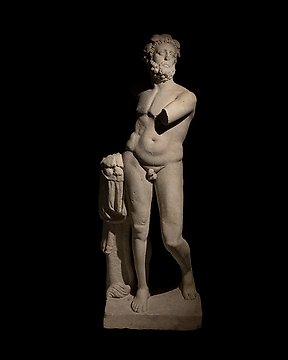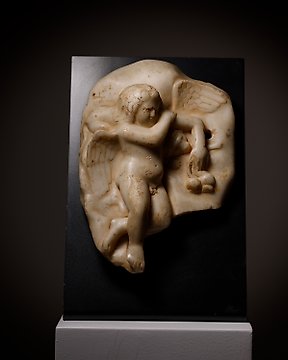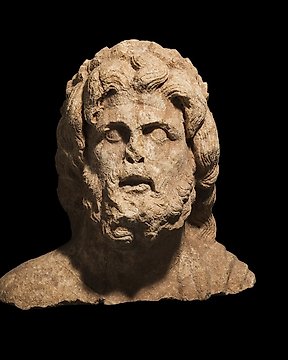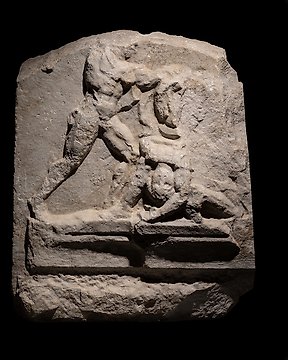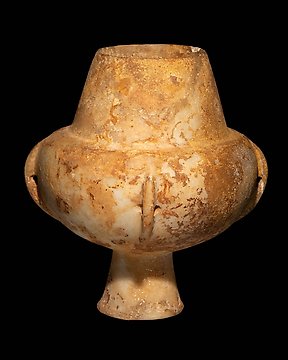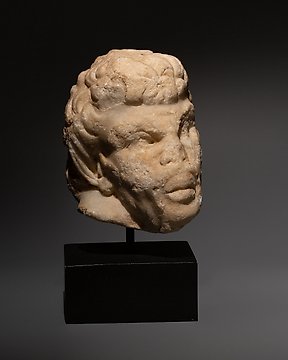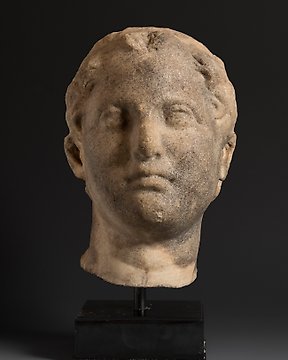All OK and with very fast shipping.
查看翻譯古羅馬 大理石 重要的木衛三軀幹。西元2世紀。 47 公分高。西班牙出口許可證和法國護照
編號 84871143
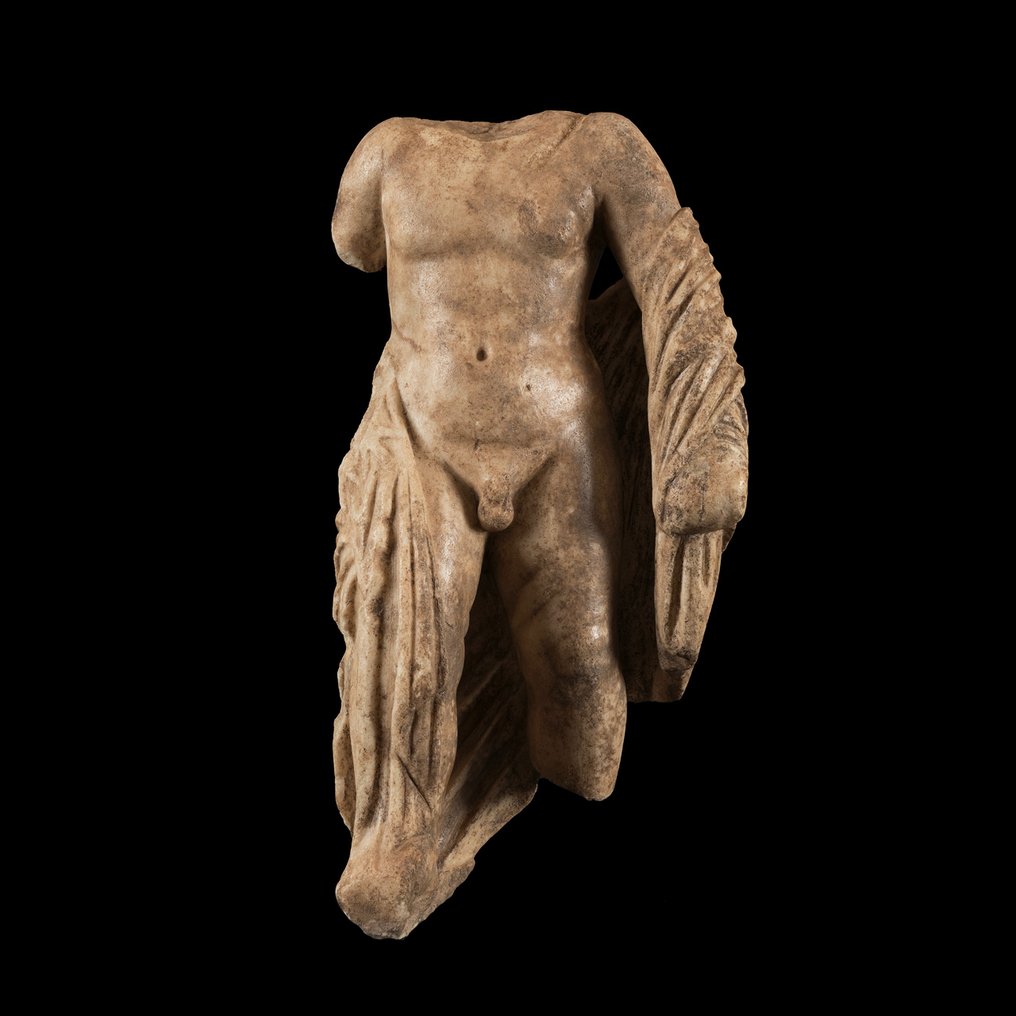
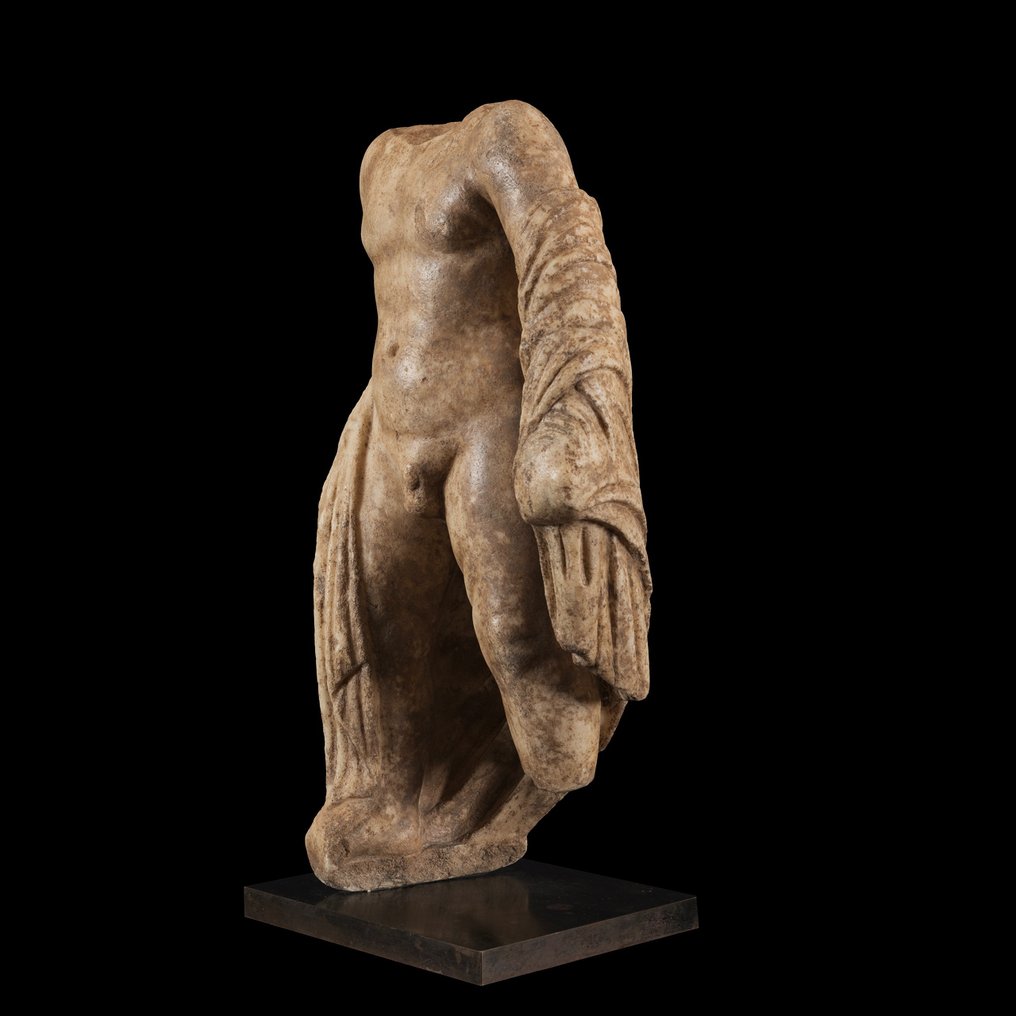

Nice Ganymede torso
- big sculpture -
CULTURE: Roman Empire
PERIOD: 2nd century AD
MATERIAL: Marble
DIMENSIONS: 47 cm height, and 50 cm heigh with stand.
PROVENANCE:
- Private collection, Mr. Firmin - Didot, 19th century.
- Auctioned at Jean Loiseau Alain Schmitz, Saint Germain en Laye, March 8, 1981, Lot 187.
- Private Collection, Marquis du G., Château de Terraube, Franica.
- Private Collection, Geneva, Switzerland .
CONDITION: IGood state of conservation, without restorations. It presents a superficial patina in reddish-brown tones of marble.
Torso belonging to a complete sculpture of the divine hero Ganymede. It is carved from a single block of marble. Possibly, given its dimensions, it would be a private sculpture, decorating a garden, although it could well be a public one.
As the lover of Zeus, the chief god of Olympus, her mythical history was often depicted by vase painters in Athens, which was well suited for all-male symposiums or formal banquets. Around 350 BC, the Athenian sculptor Leochares, who worked with Scopas on the mausoleum at Halicarnassus, modeled a bronze group of Ganymede and the eagle, an extraordinary work for its ingenious composition, which boldly ventures to the edge of the permissible by the laws of sculpture, and also by his charming treatment of the young man flying through the air. This sculpture is apparently imitated by a well-known marble group from the Vatican (fig. 1), at half natural scale. Such Hellenistic feats in defying gravity influenced the arts of the Baroque.
The attribution of this headless sculpture to Ganymede is due to the conservation on the side of his right thigh of both claws of the eagle that would be holding him to ascend to Olympus. Next to them there is a perfectly carved cavity in the shape of a rectangle, together with two slight circular holes, they are nothing more than anchor points for other parts of the sculpture, also carved in marble but a separate piece, a very common resource in classical statuary. . In this case, the eagle, which due to its anatomical complexity, if it had its wings outstretched, the artist would make this sculptural ensemble using different blocks of marble, at least one for the figure and one for the bird. The Prado Museum preserves a set in which the claws are holding the hero's waist (fig. 2), a position similar to this torso, although it would not correspond to the same composition, since it is presented on a shelf.
The nude figure is supported by the left forearm, where a mantle is wrapped around it, with accentuated folds, which passes through the lower part of the back and legs until it rests and descends through the right leg. It is worth noting the youthful appearance of the body, without developing as an adult. The detail and finesse in the sculpture is frontally correct, the back, as in most statues, is carved in a simpler way and without the same degree of polishing, a fact that indicates that it would be made to be seen from the front, located in a niche or in front of a wall.
In Greek mythology, Ganymede (fig. 3) was a divine hero from the Troas and a handsome Trojan prince. Son of King Tros, who gave his name to Troy, his mother was Callírroe. He was kidnapped by the god Zeus on Mount Ida, in Phrygia. Ganymede spent there the time of exile to which many heroes underwent in his youth, tending a flock of sheep and educating himself, together with his friends and tutors. Zeus saw him and instantly fell in love with him, and by sending an eagle or transforming himself into one, he took him to Mount Olympus, making him his lover, bedfellow, and cupbearer to the gods. Zeus later ascended Ganymede into heaven as the constellation of Aquarius (the Water Bearer), which is related to that of Aquila (the Eagle).
This myth had an important later influence, in ancient Rome the passive object of a man's homosexual desire was a catamitus, a word that evolves from the Greek Ganymede. In poetry it is a symbol of the ideally beautiful young man and of homosexual love, and related to the Trojan War it is contrasted with Helen of Troy in the role of a symbol of love for women. Zeus for the Romans is Jupiter, the main satellite of this planet was baptized with the name of Ganymede.
PARALLELS:
Fig. 1 Ganymede caught by the eagle. Roman copy of a Greek original c. 325 BC Marble. Galleria dei Candelabri, Vatican Museum. Inv. 2445.
Fig. 2 Ganymede. Roman Empire, c. 160 – 170 AD Marble. 150 cm high. Prado Museum, Madrid. E000035.
Fig. 3 Bust of Ganymede. Roman Empire, 2nd century AD. Marble. 56 cm high. Musee du Louvre, Paris. Ma535.
Notes:
- The piece includes authenticity certificate.
- The piece includes Spanish Export License.
- The seller guarantees that he acquired this piece according to all national and international laws related to the ownership of cultural property. Provenance statement seen by Catawiki.
賣家的故事
Nice Ganymede torso
- big sculpture -
CULTURE: Roman Empire
PERIOD: 2nd century AD
MATERIAL: Marble
DIMENSIONS: 47 cm height, and 50 cm heigh with stand.
PROVENANCE:
- Private collection, Mr. Firmin - Didot, 19th century.
- Auctioned at Jean Loiseau Alain Schmitz, Saint Germain en Laye, March 8, 1981, Lot 187.
- Private Collection, Marquis du G., Château de Terraube, Franica.
- Private Collection, Geneva, Switzerland .
CONDITION: IGood state of conservation, without restorations. It presents a superficial patina in reddish-brown tones of marble.
Torso belonging to a complete sculpture of the divine hero Ganymede. It is carved from a single block of marble. Possibly, given its dimensions, it would be a private sculpture, decorating a garden, although it could well be a public one.
As the lover of Zeus, the chief god of Olympus, her mythical history was often depicted by vase painters in Athens, which was well suited for all-male symposiums or formal banquets. Around 350 BC, the Athenian sculptor Leochares, who worked with Scopas on the mausoleum at Halicarnassus, modeled a bronze group of Ganymede and the eagle, an extraordinary work for its ingenious composition, which boldly ventures to the edge of the permissible by the laws of sculpture, and also by his charming treatment of the young man flying through the air. This sculpture is apparently imitated by a well-known marble group from the Vatican (fig. 1), at half natural scale. Such Hellenistic feats in defying gravity influenced the arts of the Baroque.
The attribution of this headless sculpture to Ganymede is due to the conservation on the side of his right thigh of both claws of the eagle that would be holding him to ascend to Olympus. Next to them there is a perfectly carved cavity in the shape of a rectangle, together with two slight circular holes, they are nothing more than anchor points for other parts of the sculpture, also carved in marble but a separate piece, a very common resource in classical statuary. . In this case, the eagle, which due to its anatomical complexity, if it had its wings outstretched, the artist would make this sculptural ensemble using different blocks of marble, at least one for the figure and one for the bird. The Prado Museum preserves a set in which the claws are holding the hero's waist (fig. 2), a position similar to this torso, although it would not correspond to the same composition, since it is presented on a shelf.
The nude figure is supported by the left forearm, where a mantle is wrapped around it, with accentuated folds, which passes through the lower part of the back and legs until it rests and descends through the right leg. It is worth noting the youthful appearance of the body, without developing as an adult. The detail and finesse in the sculpture is frontally correct, the back, as in most statues, is carved in a simpler way and without the same degree of polishing, a fact that indicates that it would be made to be seen from the front, located in a niche or in front of a wall.
In Greek mythology, Ganymede (fig. 3) was a divine hero from the Troas and a handsome Trojan prince. Son of King Tros, who gave his name to Troy, his mother was Callírroe. He was kidnapped by the god Zeus on Mount Ida, in Phrygia. Ganymede spent there the time of exile to which many heroes underwent in his youth, tending a flock of sheep and educating himself, together with his friends and tutors. Zeus saw him and instantly fell in love with him, and by sending an eagle or transforming himself into one, he took him to Mount Olympus, making him his lover, bedfellow, and cupbearer to the gods. Zeus later ascended Ganymede into heaven as the constellation of Aquarius (the Water Bearer), which is related to that of Aquila (the Eagle).
This myth had an important later influence, in ancient Rome the passive object of a man's homosexual desire was a catamitus, a word that evolves from the Greek Ganymede. In poetry it is a symbol of the ideally beautiful young man and of homosexual love, and related to the Trojan War it is contrasted with Helen of Troy in the role of a symbol of love for women. Zeus for the Romans is Jupiter, the main satellite of this planet was baptized with the name of Ganymede.
PARALLELS:
Fig. 1 Ganymede caught by the eagle. Roman copy of a Greek original c. 325 BC Marble. Galleria dei Candelabri, Vatican Museum. Inv. 2445.
Fig. 2 Ganymede. Roman Empire, c. 160 – 170 AD Marble. 150 cm high. Prado Museum, Madrid. E000035.
Fig. 3 Bust of Ganymede. Roman Empire, 2nd century AD. Marble. 56 cm high. Musee du Louvre, Paris. Ma535.
Notes:
- The piece includes authenticity certificate.
- The piece includes Spanish Export License.
- The seller guarantees that he acquired this piece according to all national and international laws related to the ownership of cultural property. Provenance statement seen by Catawiki.
賣家的故事
- 754
- 6
- 0
Prachtig schilderij. Zo blij mee. Zeer nette verkoper en zeer snelle levering.
查看翻譯perfect ! very fast and high quality delivery !
查看翻譯All well! Thanks.
查看翻譯Vendeur très professionnel, top +++×
查看翻譯Photos trop contrastées pour bien percevoir les défauts, mais ces défauts étaient visibles pour autant. Le "Bon état" est trompeur. Sinon, envoi rapide et correctement emballé. Frais de port exagérés.
查看翻譯Great communication, delivery and product. Came with a well made certificate of authenticity and good packaging. Overall very happy with the purchase! Delivery is a bit expensive, but I recommend it
查看翻譯Magnifique témoin du passé, envoyé avec tous les justificatifs, impeccable. Encore une fois très satisfait, un grand merci
查看翻譯Thank you for the Special offer and the fast shipping of this excellent piece of art!
查看翻譯very good description of the object, very good price for this rare item,. Fast sending (has been at my place 2 days after buying!). Definitely would buy again.
查看翻譯Sehr schön
查看翻譯As described, perfect logistic
查看翻譯great seller, everything came as should with certificate of authenticity
查看翻譯Exceptionally well packaged, description aligned with positing received
查看翻譯Really precious, but without sound...
查看翻譯Painting well packed and rapidly sent!
查看翻譯sempre grande rapidità e professionalità
查看翻譯parfait bien reçu, merci
查看翻譯Very satisfied with the small Greek Lekythos. As always (we have already bought several items from Bagot), the object was wrapped and sent immediately and with the greatest care.
查看翻譯Perfect, excellent condition, good packaging, the parcel arrived without any problems… all is perfect as usual. Thank you very much and wait for an other nice piece like this one. Gilles.
查看翻譯+++ Top vendeur professionnel comme d'habitude
查看翻譯Embora o custo de transporte esteja acima da média foi, realmente, muito bem executado e em embalagem cuidada. Expeditos e profissionais. Recomendo
查看翻譯Snel en correct en goed verpakt verzonden
查看翻譯oggetto bellissimo, fedele alla descrizione, venditore affidabile
查看翻譯Very nice piece and fast delivery
查看翻譯免責聲明
賣家保證並能證明該物品是合法取得的。 Catawiki 通知賣家,他們必須提供其居住國法律要求的文件。 賣家保證並有權出售/出口此物品。 賣家將向買家提供有關該物品的所有已知來源的資訊。 賣家確保已/將安排任何必要的許可證明。 賣家將立即通知買家有關獲得此類許可時的任何延誤。
賣家保證並能證明該物品是合法取得的。 Catawiki 通知賣家,他們必須提供其居住國法律要求的文件。 賣家保證並有權出售/出口此物品。 賣家將向買家提供有關該物品的所有已知來源的資訊。 賣家確保已/將安排任何必要的許可證明。 賣家將立即通知買家有關獲得此類許可時的任何延誤。
